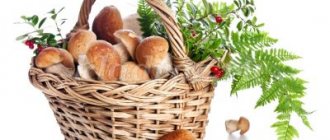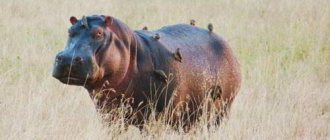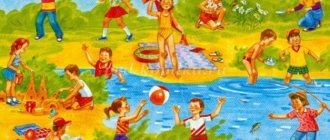Preview:
Synopsis of frontal ODD
in the preparatory group (third year of study)
on the topic: "Classification of fish."
Topic: "Classification of fish."
Priority educational area: speech development.
Integration of educational areas: socio-communicative, cognitive development.
Goal: development of the lexical and grammatical side of speech.
- Continue to expand our understanding of fish and marine life.
- Learn to classify fish.
- Continue to develop the ability to coordinate nouns on this topic with the words “one-many”.
- Strengthen the ability to form nouns with diminutive suffixes.
- Continue to develop the ability to select verbs to nouns.
- Learn to form participles from verbs.
- Develop logical thinking.
- Develop gross and fine motor skills.
- Develop skills of cooperation, goodwill, and initiative.
-panel with the image of fish;
-images of the sea, river, aquarium;
— presentation “The path from egg to fish”;
- d/i “What first, what then”;
- cards with outline images of fish (according to the number of children).
I. Creation of a motivational field (organizational moment).
The panel shows images of different fish.
- Have you guessed who we will continue to talk about today? (We will continue to talk about fish.)
II. Updating knowledge.
2. Playing with the ball: “One is many.”
Words: shark, seahorse, stingray, herring, catfish, ruff, pike, perch, crucian carp, flounder, catfish.
2. D/i “Call me affectionately.”
- Whoever will sit down and call you affectionately:
Head – head, fin – . caviar - ..., scales - ..., tail - ...,
Perch - ..., crucian carp - ..., herring - ..., shark - ..., fry - ...
Seahorse - ..., Katran - ..., lake - ..., river - ..., flounder - ....
III. Children's discovery of new knowledge.
Z. D/i “Classification of fish.”
The speech therapist suggests, when approaching the board, to choose any upside-down picture.
- You need to say the name of the fish you have chosen, where it lives and place the fish in a suitable body of water. (On the board there are images of a river, an aquarium, the sea)
Child: This is a pike. She lives in the river. This is a freshwater fish. I will put her in the river.
Child: I have a swordtail. This is an aquarium fish, it lives in an aquarium.
Child: I chose a shark. She lives in the sea. This is a sea fish.
Child: My fish is called sea bass. This is a sea fish. I'll settle
Child: I have a guppy. She lives in an aquarium because she is an aquarium fish.
Child: This is a ruff. He lives in the river. This is a river fish.
4.D/i “What first, what later.”
- Guys, you already know that nature can be living and non-living. Now think and tell me, to what nature do we classify fish? (To the living one.)
- Why did you decide so? (Fish are born, grow, feed, move, breathe,
- So, what nature do we classify fish as? (To the living one.)
- Now I will tell you how fish are born and grow. (Tale from a speech therapist showing the presentation “The Path from Egg to Fish”)
First, the mother fish lays eggs. An embryo grows in each egg. Then a tadpole grows from the embryo. Look how big his head is, that's why they're called that. Then a fry grows from the tadpole. The fry grows into a small fish. It grows and grows, and soon a real fish grows out of it.
On the topic: methodological developments, presentations and notes
The proposed lesson notes can be used by speech therapists when planning and conducting frontal lessons in a preparatory speech therapy group. The topic of this lesson: “Sounds B-B'.
The lesson presents games and exercises for developing skills in differentiating the prepositions “ON”, “UNDER” and their correct use in speech.
Goal: to strengthen children’s skills in conducting syllabic analysis of words; development of coherent speech by composing various types of sentences. Tasks: vocabulary replenishment, lexical and grammatical development.
Summary of the frontal lesson in the preparatory speech therapy group. “Snow White and the Dwarves” (theme “Dishes”) Goal: - elimination of the prerequisites for dysgraphia in preschoolers with OHP levels 3-4. Objectives: Correction.
Synopsis of a frontal lesson in a preparatory speech therapy group. Topic: “Sound and the letter Y.”
Topic: Wild animals in the winter forest. Program content. Consolidate knowledge about wild animals. Activate your used vocabulary. Develop the ability to identify basic properties and characteristics. Contribute .
Summary of a frontal lesson in a preparatory speech therapy group on the topic: “Sounds G - G*, letter G.” Topic: “Sounds G - G *, letter G” Goal: To consolidate skills.
A thematic selection of games and exercises for young children on the theme “Fish”
Goals:
Continue to enrich children's experience when acting with objects of different sizes and colors (yellow, blue, green, red). Teach children to count to two. To develop knowledge about the concepts of “circle”, “one-many” and methods of equalizing populations. Using an experimentation situation, introduce the properties of objects: “floats”, “sinks”. Develop memory, fine and gross motor skills, coordination of movements.
Equipment:
Fish toys of different colors and sizes. Blue cardboard circles. Pebbles. A bowl of water, a bowl of millet. Picture “Fish” for finger painting, finger paints. Picture “Aquarium”, glue stick, paper silhouette of a fish, plasticine. A picture depicting a lake with one fish and a lake with several fish. Card with the image of the number "1". A blank picture depicting a lake and one fish, adhesive pencils, color silhouette images of fish. A background picture depicting large and small fish of different colors with circles of the corresponding color and size pasted on them. Buttons of the appropriate color and size (large and small green, yellow, red, blue, white). A blank picture depicting an aquarium, green and brown pencils, plasticine, a stick. Hoops in yellow, green and red colors. The hoops are blue, with circles cut out of transparent oilcloth underneath them. A fish tied to a string. Trays with semolina. Audio recording: P. Tchaikovsky “Fishes” (from “Children’s Album”), song “About the Fishes”.
Summary of the speech therapy lesson “Pisces” (preparatory group for children with ODD)
Elena Mazanova
Summary of the speech therapy lesson “Pisces” (preparatory group for children with ODD)
A) Speech therapist : naming freshwater fish from subject pictures, comparing fish similar in appearance, selecting actions and signs for the subject on the topic being studied, composing phrases and simple common sentences.
B) Educators: reading stories about the fish being studied from Shorygina’s book “ Fishes , what are they?”
, getting to know the habits, living conditions and feeding conditions of freshwater fish, drawing pike, making a joint work on appliqué and origami
“Our Reservoir”
.
1. Consolidating the ability to generalize and classify on the topic “ Pisces ”
.
2. Clarification of nominative and predicative vocabulary.
3. Development of word formation skills: possessive adjectives.
4. Development of skills in coordinating cardinal and ordinal numbers with nouns.
5. Development of phonemic, syllabic analysis and synthesis .
6. Development of skills in using simple common sentences of various structures in speech.
7. Development of auditory attention and logical thinking.
1. Subject pictures: tent, fishing rod, nets, pencils, school bag, bucket...
2. Subject demonstration pictures: crucian carp, pike, bream, pike perch, catfish, ruff.
3. Image of voluminous water lilies (by number of children )
.
4. Schemes of syllables and sounds for analysis (sets by number of children )
.
5. Demonstration picture of a fisherman.
6. Scheme on a board on a pot for sound and syllabic analysis .
7. Demonstration subject pictures depicting birds and animals: fox, wolf, brown and polar bear, heron, crane, stork, seagull, lynx...
8. Image of two buckets with numbers: 1 and 2 (for syllabic analysis )
.
9. Subject silhouette handout pictures depicting freshwater fish (20 – 25 pieces)
.
10. Laces according to the number of children .






